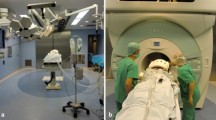Abstract
Intraoperative MR imaging has become one of the most important concepts in present day neurosurgery. The brain shift problem with navigation, the need for assessment of the degree of resection and the need for detection of early postoperative complications were the three most important motives that drove the development of this technology. The GE Signa System with the “double donut” design was the world’s first intraoperative MRI. From 1995 to 2007 more than 1,000 neurosurgical cases were performed with the system. The system was used by several different specialties and in neurosurgery it was most useful for complete resection of low-grade gliomas, identification and resection of small or deep metastases or cavernomas, recurrent pituitary adenomas, cystic tumors, biopsies in critical areas and surgery in recurrent GBM cases. Main superiorities of the system were the ability to scan without patient movement to get image updates, the ability to do posterior fossa cases and other difficult patient positioning, the easiness of operation using intravenous sedation anesthesia and the flexibility of the system to be used as platform for new diagnostic and therapeutic modalities.
Similar content being viewed by others
Abbreviations
- BWH:
-
Brigham and Women’s Hospital
- CSF:
-
CerebroSpinal Fluid
- fMRI:
-
Functional MRI
- GBM:
-
Glioblastoma Multiforme
- MEG:
-
Magnetoencephalography
- MR(I):
-
Magnetic Resonance(Imaging)
- MRT:
-
Magnetic Resonance Tomography
- NIH:
-
National Institute of Health
- OR:
-
Operation Room
References
Black PM, Moriarty T, Alexander ER, Stieg P, Woodard EJ, Gleason PL, Martin CH, Kikinis R, Schwartz RB, Jolesz FA (1997) Development and implementation of intraoperative magnetic resonance imaging and its neurosurgical applications. Neurosurgery 41:831–842, discussion 842–845
Hata N, Nabavi A, Wells WMR, Warfield SK, Kikinis R, Black PM, Jolesz FA (2000) Three-dimensional optical flow method for measurement of volumetric brain deformation from intraoperative MR images. J Comput Assist Tomogr 24:531–538
Hill DL, Maurer CRJ, Maciunas RJ, Barwise JA, Fitzpatrick JM, Wang MY (1998) Measurement of intraoperative brain surface deformation under a craniotomy. Neurosurgery 43:514–526, discussion 527–528
Nabavi A, Black PM, Gering DT, Westin CF, Mehta V, Pergolizzi RSJ, Ferrant M, Warfield SK, Hata N, Schwartz RB, Wells WMR, Kikinis R, Jolesz FA (2001) Serial intraoperative magnetic resonance imaging of brain shift. Neurosurgery 48:787–797, discussion 797–798
Nimsky C, Ganslandt O, Hastreiter P, Fahlbusch R (2001) Intraoperative compensation for brain shift. Surg Neurol 56:357–364, discussion 364–365
Reinges MH, Nguyen HH, Krings T, Hutter BO, Rohde V, Gilsbach JM (2004) Course of brain shift during microsurgical resection of supratentorial cerebral lesions: limits of conventional neuronavigation. Acta Neurochir (Wien) 146:369–377, discussion 377
Black PM (2003) Current and future developments in intraoperative imaging: MRI. In: Apuzzo MLJ (ed) The operating room for the 21st century. AANS, Park Ridge, pp 45–51
Hinks RS, Bronskill MJ, Kucharczyk W, Bernstein M, Collick BD, Henkelman RM (1998) MR systems for image-guided therapy. J Magn Reson Imaging 8:19–25
Darakchiev BJ, Tew JMJ, Bohinski RJ, Warnick RE (2005) Adaptation of a standard low-field (0.3-T) system to the operating room: focus on pituitary adenomas. Neurosurg Clin N Am 16:155–164
von Keller B, Nimsky C, Ganslandt O, Fahlbusch R (2004) Intraoperative MRI in 62 patients with pituitary adenoma. Deutsche Gesellschaft für Neurochirurgie. Ungarische Gesellschaft für Neurochirurgie. 55. Jahrestagung der Deutschen Gesellschaft für Neurochirurgie e.V. (DGNC), 1. Joint Meeting mit der Ungarischen Gesellschaft für Neurochirurgie. Köln, 25.-28.04.2004. Düsseldorf, Köln: German Medical Science DocMO.01.05
Martin CH, Schwartz R, Jolesz F, Black PM (1999) Transsphenoidal resection of pituitary adenomas in an intraoperative MRI unit. Pituitary 2:155–162
Lacroix M, Abi-Said D, Fourney DR, Gokaslan ZL, Shi W, DeMonte F, Lang FF, McCutcheon IE, Hassenbusch SJ, Holland E, Hess K, Michael C, Miller D, Sawaya R (2001) A multivariate analysis of 416 patients with glioblastoma multiforme: prognosis, extent of resection, and survival. J Neurosurg 95:190–198
Lagerwaard FJ, Levendag PC, Nowak PJ, Eijkenboom WM, Hanssens PE, Schmitz PI (1999) Identification of prognostic factors in patients with brain metastases: a review of 1292 patients. Int J Radiat Oncol Biol Phys 43:795–803
Moriarty TM, Quinones-Hinojosa A, Larson PS, Alexander ER, Gleason PL, Schwartz RB, Jolesz FA, Black PM (2000) Frameless stereotactic neurosurgery using intraoperative magnetic resonance imaging: stereotactic brain biopsy. Neurosurgery 47:1138–1145, discussion 1145–1146
Pollack IF, Claassen D, al-Shboul Q, Janosky JE, Deutsch M (1995) Low-grade gliomas of the cerebral hemispheres in children: an analysis of 71 cases. J Neurosurg 82:536–547
Schwartz RB, Hsu L, Black PM, Alexander ER, Wong TZ, Klufas RA, Moriarty T, Martin C, Isbister HG, Cahill CD, Spaulding SA, Kanan AR, Jolesz FA (1998) Evaluation of intracranial cysts by intraoperative MR. J Magn Reson Imaging 8:807–813
Schwartz RB, Hsu L, Wong TZ, Kacher DF, Zamani AA, Black PM, Alexander ER, Stieg PE, Moriarty TM, Martin CA, Kikinis R, Jolesz FA (1999) Intraoperative MR imaging guidance for intracranial neurosurgery: experience with the first 200 cases. Radiology 211:477–488
Hynynen K, Vykhodtseva NI, Chung AH, Sorrentino V, Colucci V, Jolesz FA (1997) Thermal effects of focused ultrasound on the brain: determination with MR imaging. Radiology 204:247–253
Author information
Authors and Affiliations
Corresponding author
Editor information
Editors and Affiliations
Rights and permissions
Copyright information
© 2011 Springer-Verlag/Wien
About this chapter
Cite this chapter
Black, P., Jolesz, F.A., Medani, K. (2011). From Vision to Reality: The Origins of Intraoperative MR Imaging. In: Pamir, M., Seifert, V., Kiris, T. (eds) Intraoperative Imaging. Acta Neurochirurgica Supplementum, vol 109. Springer, Vienna. https://doi.org/10.1007/978-3-211-99651-5_1
Download citation
DOI: https://doi.org/10.1007/978-3-211-99651-5_1
Published:
Publisher Name: Springer, Vienna
Print ISBN: 978-3-211-99650-8
Online ISBN: 978-3-211-99651-5
eBook Packages: MedicineMedicine (R0)




